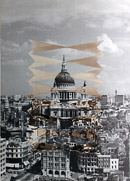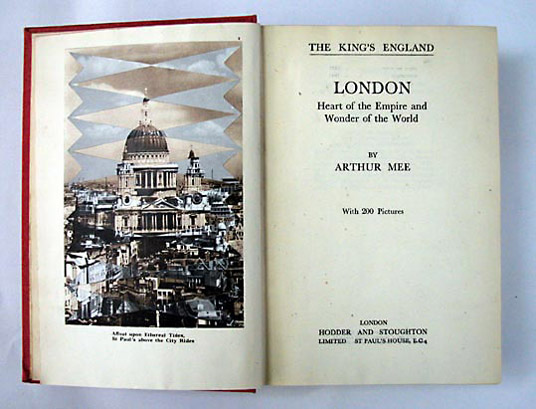 |
Abigail Reynolds |
|
City breaks statement
The Universal Now: St Paul’s 1937 1965
The Universal Now. Well, it’s a kind of
way of thinking ‘what if I could travel in time…’
I thought that if I did it’d be a bit hard to see because you’d
have one time stuck in your head and another time coming at you
through your eyes and maybe these two views – that of the memory
and that of the scopic would interfere with one another. There’s
something emotional about that vanished moment that can only be
partially re-accessed. When I think about time travel La Jetee by
Chris Marker comes to me. It describes a post-war world in which
everything we now take for granted (children, sky, park, museum)
has gone. The clearest emotional response to this is to feel fully
and appreciatively connected to those ordinary aspects of the city
once again. The idea of traveling in time is melancholy as well
as an exciting. These ideas are already contained within the most
standard photograph; The Universal Now also extends the way a photograph
can only record a moment that has necessarily gone. The city is an energy.
It continually reinvents itself. That’s hard to intersect with
visually, especially as it’s so over-rich visually and experientially
already. I have a real hesitation in producing more images of the
city surface, proliferating it further. In previous work I have
tried to cut through the visual surface of the city to work with
something more structural. The urge to work with pre-exisiting tourist
images that only reflect the surface of the city is also the flip
side of my earlier decision. I sometimes think that in making work
every action really does have an equal and opposite reaction. The
table/door/display case hybrid that the books are closed in is part
of an approach I’m taking in some parallel sculptural work
at the moment to do with modeling words. I prefer the idea of someone
picking up a book, flicking through it and just discovering that
someone has tampered with some of the pages. Maybe I’ll find
a way to do that later. There are real dangers
in working to brief, like making art just to honour a commitment
(which is pointless) and there’s a skill to it, just as there
is to generating work via a studio process. So, I don’t think
of working to a project as a false pretence. I don’t have a
studio now, I too easily feel trapped by the studio moment, which
for me is portentious and isolated. I like art to be a way of thinking
about things very actively and straightforwardly, which for me means
being based out in other places, and only occasionally having recourse
to a studio as a building area – I often just do this in the
gallery. In Helsinki I was directed
to a quote: “It is uninteresting to think about art;
we must instead think through it. Both the work itself and the common
exhibition project are thinking machines. Through them we reflect
upon our own reality. Art creates models of thought and offers our
perceptions of reality parallel narratives and strategies. These
models serve to understand, to scan, to challenge life.” This
is of course a very generalized statement and can be loosely applied
to any work of art. I like it all the same. I think of the studio
as rather a false pretence. Like the gallery, it cuts off the outside
world and privileges art –as-art-object. As I write, I am aware
that this is the opposite to the ‘hobby’ part of art making
that I have just outlined. Making art always involves trying to
reconcile a whole set of confliciting desires; towards yourself,
towards the audience, towards the set of values you are pushed along
by, towards the materials you happen to be working with. In this
work I am showing now, there are aspects that I have let drop because
the context of the show already contains a consideration of process.
It’s very hard to make a work that retains a genuine connection
to the performance of making it, and flags that up more than usual.
As a generation of artists
I don’t think we are frank enough about the ways of thinking
that have generated the work. There’s a fear of saying too
much, which means that nothing is said.
Works at the Whitechapel Project
Space: The Universal Now: Houses of Parliament from
the Thames 1951 1984 |

